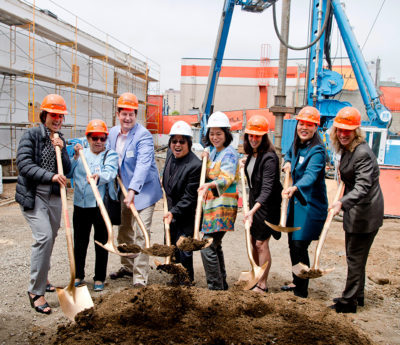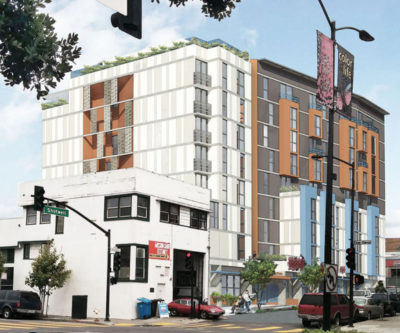First new, affordable senior housing breaks ground in the Mission

When completed, the nine-story building will provide 94 units of affordable housing, with on-site supportive services: 74 apartments for low-income seniors, 19 for seniors experiencing homelessness, and one for the building manager. The project is a partnership between the Mission Economic Development Agency (MEDA) and the Chinatown Community Development Center (Chinatown CDC).
The building is expected to be completed by 2020. It will also have staff offices, four rooftop terraces, landscaped garden courtyards, a spacious community room with a kitchen, 22 bicycle storage spaces, solar hot-water system, a community laundry room, and an enhanced security system.
“Finally, finally, it’s taken a long time to get here. It doesn’t get much better than this,” said District 9 supervisor Hillary Ronen. “It’s very special that this first project is for seniors who have given so much to the community and who deserve to age in dignity and safety.
More housing to come
“Housing should be a human right and we’re hell bent on making it a human right in San Francisco,” Ronen continued. “My goal is 5,000 units in the next decade.”
Olinda Orellana, a community leader and Faith in Action senior advocate who was honored for her 30 years of organizing for affordable housing, said “We deserve to live out our last days with dignity and security. We’ll continue to struggle and bring people together. This isn’t the last affordable project in our neighborhood.”

Six more affordable housing projects in the Mission are currently being evaluated—for a total of 780 units—according to Amy Beinart, a Ronen aide specializing in housing. “Some for seniors, others for families; 20 percent will be set aside for the formerly homeless,” said Beinart, who is also working with MEDA, Mission Housing Development Corporation and Mission Neighborhood Centers to find more sites.
After a blessing and dance performance by Danza Azteca Xitalli-Xoloti, MEDA Executive Director Luis Granados reminded the crowd of officials and community members gathered for the occasion that more than 8,000 Latinos have been forced from their homes in the Mission District since 2000.
“Being on a fixed, low income should not mean being displaced,” Granados said, adding that the project only came about through “lots and lots of community work. This is how MEDA and the community work, and this is how we will continue to work.”
Money for the project comes from voter-approved Prop A, the city’s Affordable Housing Fund, and the federal HOME Investment Partnerships Program. The nine-story building is also the first to seek a density bonus through the city’s Affordable Housing Bonus Program.
“This development makes the city a better place to live,” said Kate Hartley, director of the Mayor’s Office on Housing and Community Development.





